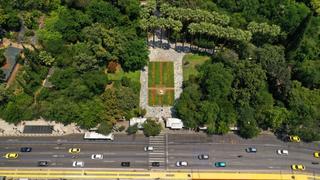
Preservation of the National Garden of Athens

National Garden of Athens
Photo: shutterstock

The Bavarian State Ministry of Finance, Land Development & Homeland and the City of Athens agreed to cooperate on the preservation and maintenance of the National Garden of Athens. In the Memorandum of Understanding the Bavarian Administration of State Palaces, Gardens and Lakes declared its willingness to support the City of Athens in the preservation and maintenance of the National Garden of Athens. The Schwarz Foundation is funding the consultancy for the garden maintenance programme.
Today, the grant, which extends in the years 2020-2022, secures the appointment of Mrs Katrin Schulze, a leading supervising consultant recommended by the recommendation of the Bavarian Administration of State Palaces, Gardens and Lakes. The outcome will be a sustainable technical framework that will respect the National Garden’s historical, botanical and biological specificity within which all restoration work will be executed. The project is initiated in close cooperation with the Director of the National Garden of Athens, Mrs Katerina Agorastou, the landscape architect Elissavet Bargianni and the assistance of The Friends of National Garden Society (ΕΦΕΚ).
Outlook
A Parkpflegewerk is a garden monument conservation report that serves as a basis for the conservation, preservation and restoration of historic gardens and parks in a manner appropriate to the monument. Park maintenance works include a detailed historical analysis of the respective garden complex, a survey of all existing elements and structures, and an assessment of the existing situation. From the resulting garden monument conservation target planning, restoration and maintenance measures are derived for short-, medium-, long-term and recurring work.
The National Garden
The "Royal Garden" (National Garden) in Athens was created during the reign of King Otto of Greece (1815-1867) from 1837 onwards according to the ideas of his wife Amalie, née Duchess of Oldenburg (1818-1875). It is an important work of European garden art, but also a testimony to the common German-Greek history and is closely connected with the development of Athens into the new Greek capital in the 19th century.
Amalie not only had the garden laid out, but also actively promoted the greening of Athens and the improvement of the surrounding area. She also founded an experimental tree nursery and the first botanical garden in Athens. Following ideas of contemporary agrarian reformers, she established the model estate of Heptalophos to demonstrate modern agricultural production methods and to test newly introduced crops. To implement her ideas, Amalie employed experts from Germany and France, including agronomists, botanists and garden artists. Amalie's court gardener was in close contact with the Botanical Garden in Berlin, published in German journals about his botanical research in the National Garden and sent seeds and plants to Germany.
Today, the National Garden is characterised by valuable old trees and an extraordinary variety of plants of high botanical interest, which can be traced back to Queen Amalie's passion for collecting and importing plants. The preservation of the valuable historic tree population is therefore of particular importance, although some of it will reach the end of its natural life expectancy in the next few decades. For a long-term preservation of the entire stock, therefore, in addition to professionally qualified tree care, replanting is also necessary, which should be carried out according to a basic concept.
Another special feature of the National Garden is the historical irrigation system of cisterns, ditches and gutters fed from an ancient water pipe, which has been preserved to this day. Structural elements, furnishings such as benches, arbours, etc. as well as paths with dimensions and materials are also characteristic components of a garden monument. They are present in the National Garden on a large scale from the time of its creation and later design phases and must be maintained and preserved in their present form.
As a "green oasis" in the urban area, the National Garden today assumes an important urban climatic function and is an important point of attraction and recreation for Athenians and tourists.
In terms of horticultural art and horticulture, its importance lies, among other things, in the fact that Queen Amalie brought 19th century horticultural trends from Western Europe to Greece and gave significant impulses for the development of urban greenery in Athens. Of particular interest is how her design ideas were technically implemented with the help of international experts, since the Athenian climate made it considerably more difficult to create a park according to the Western European model.



